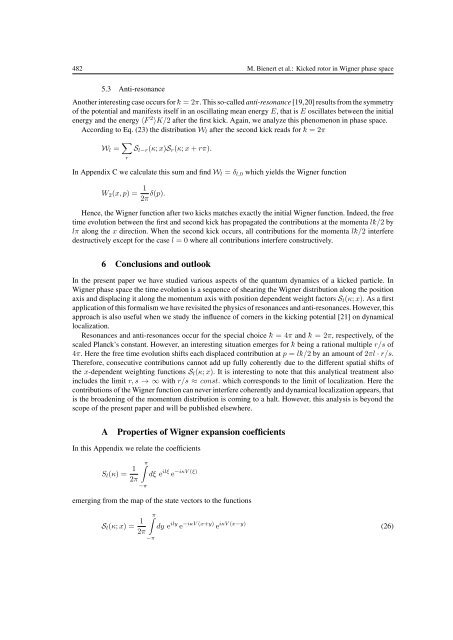Kicked rotor in Wigner phase space - The University of Texas at Austin
Kicked rotor in Wigner phase space - The University of Texas at Austin
Kicked rotor in Wigner phase space - The University of Texas at Austin
Create successful ePaper yourself
Turn your PDF publications into a flip-book with our unique Google optimized e-Paper software.
482 M. Bienert et al.: <strong>Kicked</strong> <strong>rotor</strong> <strong>in</strong> <strong>Wigner</strong> <strong>phase</strong> <strong>space</strong><br />
5.3 Anti-resonance<br />
Another <strong>in</strong>terest<strong>in</strong>g case occurs for k- =2π. This so-called anti-resonance [19,20] results from the symmetry<br />
<strong>of</strong> the potential and manifests itself <strong>in</strong> an oscill<strong>at</strong><strong>in</strong>g mean energy E, th<strong>at</strong> is E oscill<strong>at</strong>es between the <strong>in</strong>itial<br />
energy and the energy 〈F 2 〉K/2 after thefirst kick. Aga<strong>in</strong>, weanalyzethis phenomenon <strong>in</strong> <strong>phase</strong><strong>space</strong>.<br />
Accord<strong>in</strong>g to Eq. (23) thedistribution Wl after the second kick reads for k- =2π<br />
Wl = <br />
Sl−r(κ; x)Sr(κ; x + rπ).<br />
r<br />
In Appendix C wecalcul<strong>at</strong>ethis sum and f<strong>in</strong>d Wl = δl,0 which yields the <strong>Wigner</strong> function<br />
W2(x, p) = 1<br />
2π δ(p).<br />
Hence, the <strong>Wigner</strong> function after two kicks m<strong>at</strong>ches exactly the <strong>in</strong>itial <strong>Wigner</strong> function. Indeed, the free<br />
time evolution between the first and second kick has propag<strong>at</strong>ed the contributions <strong>at</strong> the momenta lk- /2 by<br />
lπ along the x direction. When the second kick occurs, all contributions for the momenta lk- /2 <strong>in</strong>terfere<br />
destructively except for the case l =0where all contributions <strong>in</strong>terfere constructively.<br />
6 Conclusions and outlook<br />
In the present paper we have studied various aspects <strong>of</strong> the quantum dynamics <strong>of</strong> a kicked particle. In<br />
<strong>Wigner</strong> <strong>phase</strong><strong>space</strong>thetimeevolution is a sequence<strong>of</strong> shear<strong>in</strong>g the<strong>Wigner</strong> distribution along theposition<br />
axis and displac<strong>in</strong>g it along the momentum axis with position dependent weight factors Sl(κ; x). As a first<br />
applic<strong>at</strong>ion <strong>of</strong> this formalism we have revisited the physics <strong>of</strong> resonances and anti-resonances. However, this<br />
approach is also useful when we study the <strong>in</strong>fluence <strong>of</strong> corners <strong>in</strong> the kick<strong>in</strong>g potential [21] on dynamical<br />
localiz<strong>at</strong>ion.<br />
Resonances and anti-resonances occur for the special choice k - =4π and k - =2π, respectively, <strong>of</strong> the<br />
scaled Planck’s constant. However, an <strong>in</strong>terest<strong>in</strong>g situ<strong>at</strong>ion emerges for k - be<strong>in</strong>g a r<strong>at</strong>ional multiple r/s <strong>of</strong><br />
4π. Herethefreetimeevolution shifts each displaced contribution <strong>at</strong> p = lk - /2 by an amount <strong>of</strong> 2πl · r/s.<br />
<strong>The</strong>refore, consecutive contributions cannot add up fully coherently due to the different sp<strong>at</strong>ial shifts <strong>of</strong><br />
the x-dependent weight<strong>in</strong>g functions Sl(κ; x). It is <strong>in</strong>terest<strong>in</strong>g to note th<strong>at</strong> this analytical tre<strong>at</strong>ment also<br />
<strong>in</strong>cludes the limit r, s →∞with r/s ≈ const. which corresponds to the limit <strong>of</strong> localiz<strong>at</strong>ion. Here the<br />
contributions <strong>of</strong> the <strong>Wigner</strong> function can never <strong>in</strong>terfere coherently and dynamical localiz<strong>at</strong>ion appears, th<strong>at</strong><br />
is the broaden<strong>in</strong>g <strong>of</strong> the momentum distribution is com<strong>in</strong>g to a halt. However, this analysis is beyond the<br />
scope <strong>of</strong> the present paper and will be published elsewhere.<br />
A Properties <strong>of</strong> <strong>Wigner</strong> expansion coefficients<br />
In this Appendix we rel<strong>at</strong>e the coefficients<br />
Sl(κ) = 1<br />
π<br />
2π<br />
−π<br />
dξ e ilξ −iκV (ξ)<br />
e<br />
emerg<strong>in</strong>g from themap <strong>of</strong> thest<strong>at</strong>evectors to thefunctions<br />
Sl(κ; x) = 1<br />
π<br />
2π<br />
−π<br />
dy e ily e −iκV (x+y) iκV (x−y)<br />
e<br />
(26)
















